Sights of Gyumri
Gyumri is Armenia’s second city. After the 1988 earthquake Gyumri has lost the most of its industrial capacities, cultural institutions, buildings.
As an old town, Gyumri has rich history and unique style.
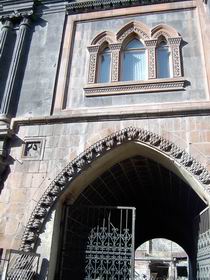
Hotel "Paris"  | | The “Kumayri” Historic District, an open air museum under the heaven. It has over 1,000 18th and 19th century buildings and is the only place in Armenia to see an authentic historic Armenian city. Nearly all the buildings in the Kumayri District have survived two major earthquakes – in 1926 and 1988 – and quite a number of buildings show signs of damage from both! But because of the sheer number of buildings, and the efforts made to completely restore some of the most important ones, the Kumayri District leaves most visitors with a strong impression of the city’s romantic past as a great center of Armenian culture, a major outpost of the Russian Empire, and a thriving center of trade where rich Armenian families built lavish mansions and founded great churches and cathedrals.
|
To get to know the Kumayri District better, download your own copy of the Kumayri Walking Tour brochure: http://www.shirakinfo.am, or contact the Kumayri Historic Preservation Museum at (+374) 41 23434.
Gyumri has a distinct look and style, residents own dialect (very close to Western Armenian).
Finally, Gyumri is a must see for anybody with a professional or personal interest in post-disaster recovery or development in general. At the present time, several major recovery programs are underway in the city, and its rapid transformation is visible everywhere and in every sphere. Residential construction, energy projects, coordinated, participatory urban planning and civil society building are all going on here at a middle pace. The signs of progress are visible as thousands of families move from the “temporary” shelters they have inhabited (known as “domics”) since the 1988 earthquake into private houses and apartments. New apartment buildings, schools, public buildings and community centers are under construction everywhere.
The Kumayri historic district
The Kumayri historic district lies at the core of present-day Gyumri, Armenia. Over the years, Armenia's second largest city has been named Kumayri, Gyumri, Alexandrapol, Leninakan, then briefly Kumayri again and now Gyumri. Archeological excavations have shown that the area has been populated since at least the third millennium BC. Numerous dwelling places, graves and settlements have been found. The first recorded mention of Kumayri is from 773 and describes the revolt against Arab domination led by Artavazd Mamikonyan that resulted in a revival of Armenian statehood. Later, during and after the reign of Bagratids, Kumayri developed into a well-built modern town that was a center of commerce for the region.
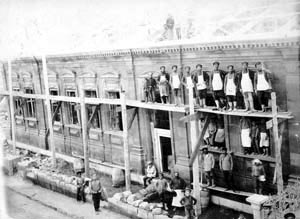
Gyumri School #1 Under Construction
in the Late 1800s | | The Kumayri Historic District covers an area of about 1000 hectares and over 1600 buildings and monuments of historic significance, including the ho-mes of important Armenian cultural figures and wealthy families from the pre-Soviet period, and several churches, including a Russian chapel. Much of the historic district suffered from the 1988 earthquake but the basic fabric remains intact and most of the damaged buildings are restorable. |
"Sev Ghul" ("Black Sentry")
(the locationin in Gyumri map - A6)
| As you arrive at the Sev Ghul, you will see the colossal statue of "Mother Armenia" on an adjacent hill. Beyond the statue lies the Turkish border. In good weather, villages in Turkey are visible in the distance. Gyumri was annexed to The Russian Empire after the last Russo-Turkish war in the 1820s. The city was a significant military foothold for Russia and in the 1830s, plans were drawn up for massive fortifications, including the Sev Ghul. | |
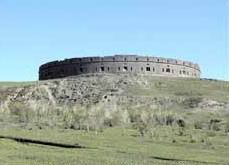
Sev Ghul 
|
The fortress, heavily armed, had three entrances: from the Yerevan, Kars and Akhltskha Roads. In case of a siege, the fortress site could accommodate 15,000 soldiers and officers. At present, the 102nd military division of the Russian Federation is stationed here.Ride minibus line No. 6 from near the Mother Armenia statue to the Russian Chapel.
The Russian Chapel
(the locationin in Gyumri map - B7)
|

The Russian chapel  | | This ritual Russian Orthodox structure, used in earlier times in conjunction with funeral rites, is known as the "Plplan Zham" (Shimmering Chapel) because of its silver colored reflective roof. The chapel was built 1879-80. A Russian military cemetery was adjacent.
You'll pass by The Yuzbashyan Houses on your right on the way from the Russian Chapel to the Central Park. The Yuzbashyans were well-known upper class merchants in Alexandrapol. The grouping consisted of the Yuzbashyans' mansion and an adjacent rental section, which was damaged in the 1988 earthquake. The Central Park is only a few steps from here. |
Gyumri's Central Park
(the locationin in Gyumri map - B6)
| Gyumri's Central Park was founded in the 1920s on the site of the old city cemetery. The park offers sweeping views of the city to the south, east and west. Amusement rides, vendors and a cafe make the Park a good place to take a break before you continue on your tour. Look for the old theater building, located at one of the Park's entrances, where in 1913, the first Armenian opera "Anush" premiered, with composer Armen Tigranyan conducting. The theater is on the site of an earlier theater, where in 1861 an amateur | |
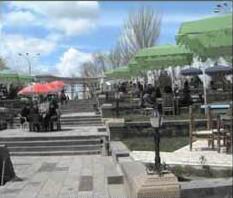 |
group inaugurated a rebirth of Armenian performance art in Gyumri.
The Pedagogical Institute
(the locationin in Gyumri map - B6)
The Pedagogical Institute located across the street from the Central Park's main entrance, was built at the end of the 19th century as a business college. At the time, it was one of the world's first institutions of higher learning dedicated solely to business, and was renowned all over the Transcaucasus for its high educational standards. During Soviet times, the building became a Teacher's College, but it was severely damaged in the 1988 earthquake. Currently, reconstruction is underway by The Gyumri Pedagogical Institute, which will re-occupy the building once it is completed.
Walk past the Pedagogical Institute building going north along Ajemyan Street. You will arrive at Gyumri's oldest manufacturing site - The Gyumri Brewery - and the "Polos Mukuch" restaurant.
"Polos Mukuch" restaurant
(the locationin in Gyumri map - B5)
Polos Mukuch, named for a beloved Gyumri folk humorist, was built in the 1860s as a small inn and later sold to the brewery. Polos Mukuch has distinctive interior and exterior architecture and a hospitable staff - a good place to stop for refreshments or a meal along your tour. You may also want to avail yourself of its clean rest rooms (don't forget to ask permission).
| 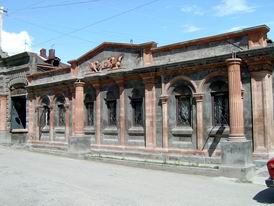
The Polos Mukuch brewery 
| | Directly across from Polos Mukuch is the old Gyumri brewery, built in 1895 by the upper class merchant Tsaghikyan. The brewery functioned until 1982. Renovation is now in progress.
Continue north along Ajemyan Street past Polos Mukuch and the Brewery and turn right at Rustaveli Street (14th Street). Follow Rustaveli to the intersection of historic Abovyan Street (see below) to the St. Nishan Apostolic Church.
|
St. Nishan Apostolic Church (Surp Nishan)
(the locationin in Gyumri map - C5)
| St. Nishan Apostolic Church (Surp Nishan) was built in 1870. The structure was used for other purposes during the Soviet period, but was reconsecrated in 2001 in conjunction with the 1700th anniversary of the adoption of Christianity in Armenia. The renovation of this lovely structure, whose domes were a distinctive feature of turn-of-the-century Gyumri, is complete. | |
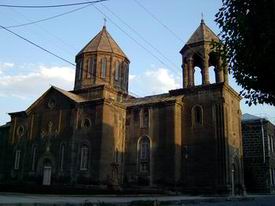
Surb Nshan 
|
Continue along Rustaveli Street to Shahumyan Street, and turn right on Shahumyan Street. At Shahumyan Street, you will see the old Gyumri house that is now slated to be restored and used as the Mher Mkrtchyan Museum (Mkrtchyan was a well-known actor from Gyumri). Continuing along Shahumyan Street toward Freedom Square (Central Square), look for the newly restored Avetik Isahakyan Home and Museum. Here you can stop in and get acquainted with the great poet's life and work. Isahakyan was a 19th Century poet born in Gyumri who wrote about Gyumri and the Shirak region.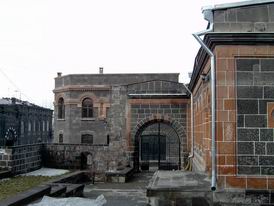
Hovhanness Shiraz Home and Museum  | | Next door, at the intersection of Gorky and Shahumyan Streets, is the Hovhanness Shiraz Home and Museum. Both the Isahakyan and Shiraz Museums are excellent examples of turn-of-the-century architecture, and they also provide a feel for the rich cultural life that prevailed in Gyumri during that period.
|
Gyumri Restaurant
(the locationin in Gyumri map - C6)
| The Gyumri Restaurant is across Gorky Street and to the left from the Shiraz Museum. The restaurant is located in a picturesque but dilapidated courtyard typical of old Gyumri. The restaurant's vaulted ceilings and distinctive stonework offer a remarkably well-preserved example of interior architecture. | | 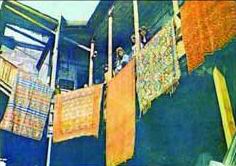 |
Abovyan Street
(the locationin in Gyumri map - C5 - C6)
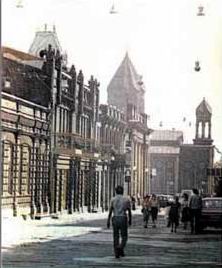 | | Continue along Gorky Street to the corner of Abovyan Street, where you will see the Aesthetics Education Center where Gyumri's gifted children develop their talents in music and the arts. The Aesthetics Education Center is located in an 1880s building in the former commercial section of the city. |
| One of the buildings being reconstructed is The Raphaelyan House, built in the 1880s by the wealthy family of that name as a rental apartment building. Later, the building became the Paris Hotel, and during the Soviet period, it served as a maternity hospital. Currently, the building is being reconstructed by its private owners. | | 
Hotel "Paris"  |
The Aslamazyan House
(the locationin in Gyumri map - C5 - C6)
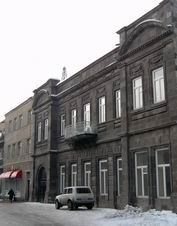 | | The Aslamazyan House, also on Abovyan Street, was built in the 1880s. The Aslamazyan sisters, Soviet-era artists, lived and worked here, and the building is restored in 2004 as a museum to house the nearly 700 drawings, paintings, and other works the sisters left to the City of Gyumri.
Follow Abovyan Street to Freedom Square, previously known as Central Square. Stand in the center of the Square and spin around 360 degrees. You will see four wonderful churches: St. Nishan Church; St. Astvatsatsin Church (also called "Yot Verk", or "Seven Wounds") on the Square's north side; the partially ruined All Savior’s Church on the south side; and the old St. Astvatsatsin Armenian Catholic Church on a high point to the west of the square. |
The latter may be hard to see because it lost its domes in the 1926 earthquake and was never restored. Carved inscriptions on the southeast wall of the Catholic Church indicate that the church was built in 1843. The partially destroyed church has been in residential use since the Soviet period, but there is now some hope that this important Gyumri landmark may be restored. A visit to the "Yot Verk" Church will be well worth your while. You will see devout Gyumritsis lighting candles and praying, and if you're lucky, you may also see a baptism, wedding or other ceremony in the ancient traditions of the Armenian Church.
| Behind the All Savior’s Church is another public square, named after the church, which together with Freedom Square and the Church itself, may be considered the true heart of Gyumri. All Savior’s Square was recently refurbished and should be a pleasant place to take a rest on your tour.The buildings of Musical School # 2, The Courthouse and the Armen Tigranyan Home and Museum are also among the historical and cultural monuments of the Kumayri Historic District. These buildings are situated along the continuation of Abovyan Street from Freedom Square. | | 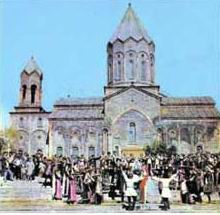 |
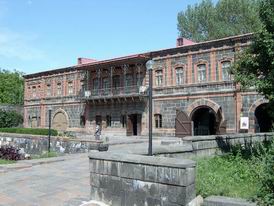
The Dzitoghtsyan Museum 
| | At the end of the marketplace, cross to the far side of Haghtanak Avenue to The Dzitoghtsyan Home and Museum (14). This old Gyumri mansion houses collections covering both the history and everyday life of Gyumri as well as paintings and other works of art. Part of the ground floor of the mansion has been converted into a wonderful restaurant named "Fayton Alek." The vaulted interior ceilings and traditional rugs and other decorations are well worth seeing,
|
and Fayton Alek is a good place to rest and have a meal at the end of your long tour.
Reference: http://www.shirakinfo.am |












